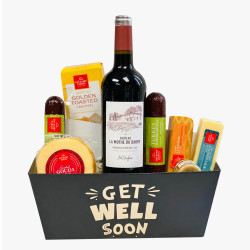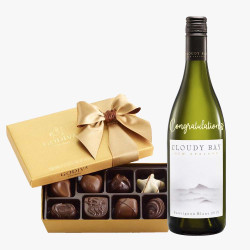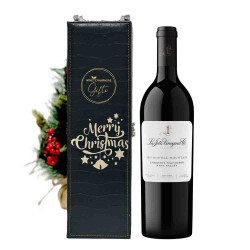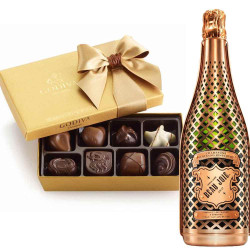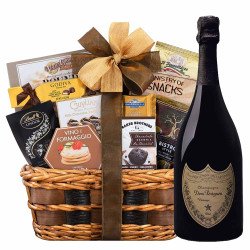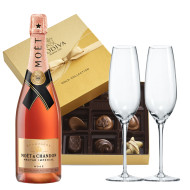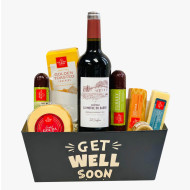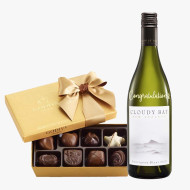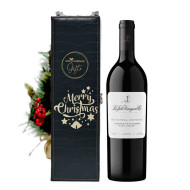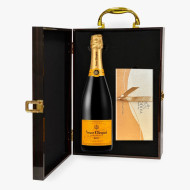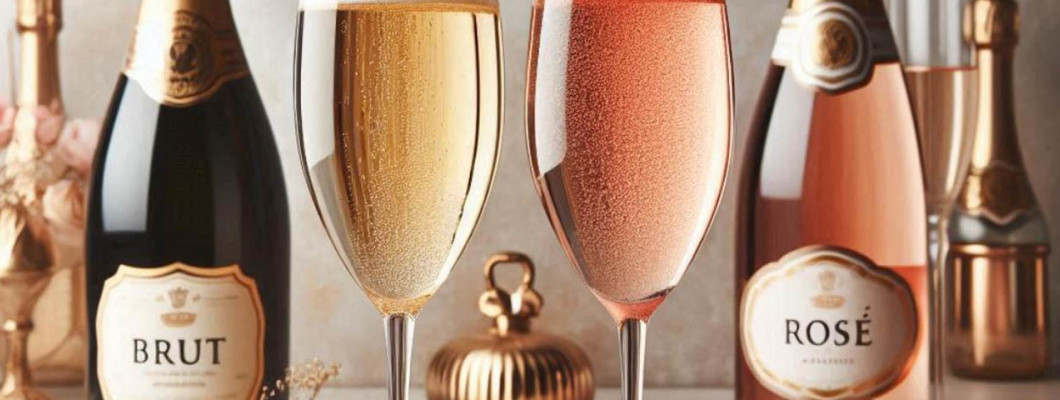
Champagne is a luxurious and festive drink when it comes to celebrating any special occasion or enjoying a night with friends. These sparkling wines are widely loved for their crisp acidity, persistent effervescence and nuanced flavor profile. But with the vast world of types of Champagne, two popular styles stand out for their authentic quality, sharing the allure and celebratory nature of champagne are Brut and Rose.
They both offer distinct experiences that cater to different tastes, pairings, and occasions. Whether you’re hosting a festive gathering with friends and family or selecting a bottle for a romantic evening, understanding the difference between Brut and Rosé champagne will help you make the right choice for your events.
This article will discuss everything you need to know about Brut vs Rose champagne, from their flavor characteristics, to the best suited occasion and ideal food pairings. I promise by the end of this blog, you’ll have a clear idea of which champagne suits your coming up celebrations and meet ups.
Sit back and pop open a bottle of your favorite finest sparkling wine, and let’s begin the journey through the world of champagne and their iconic sparkling wine.

What is Brut Champagne?
Brut Champagne is the most popular style in champagne, accounting for over 80% of overall Champagne produced.
The term “Brut” refers to the Champagnes sweetness level. Which means it's a dry style with a residual sugar content of less than 12 grams per liter, resulting in wine low in sugar and has a crisp, refreshing taste. It is a popular choice for those who appreciate a refined, clean finish.
Significance of Brut Champagne:
- Process of Brut Champagne Production: The process follows the traditional method, where the wine undergoes two fermentations. The grapes are harvested and pressed, the juice is sent for the first fermentation in a stainless steel tank. After the first step the wine is bottled with added yeast and sugar, which initiates second fermentation that creates characteristic bubbles. The wine is aged, then disgorged to remove sediment, and minimal sugar is added before corking.
- Taste Profile: Popularly known for its crisp acidity and delicate bubbles with notes of green apple, citrus, and bread, with a subtle mineral quality that lingers on the palate. Its neutral flavor makes it a versatile choice, making it an ideal celebratory drink, pairing well with a wide range of foods.
What Makes Brut Champagne Special?
- Crisp and Dry: The low sugar content leads to a dry taste, often with citrus notes such as lemon, lime, and grapefruit.
- Refined: Ideally known for its sophisticated and elegant profile, offering luxurious experience.
- Zesty and Refreshing: Its dryness contributes to its zesty, refreshing, and crisp character, perfect for toasting at birthdays, weddings, and other events.
What is Rosé Champagne?
On the other hand, Rose Champagne brings a vibrant, fruity, and romantic element to the champagne world. It has delicate blush color, perceived as more festive and playful compared to Brut. The pink hue is typically by blending Pinot Noir or Pinot Meunier grapes with traditional champagne or by leaving black grape skin with juice for a short time. Rosé tends to be fruitier and more fragrant.
Significance of Rose Champagne:
- Making Process of Rose Champagne:It goes through a process more complex than other Champagne styles. It includes two primary methods: blending and maceration. In blending, a small amount of red wine is mixed with white for the desired color. In the maceration method the black grape skin is soaked briefly with the juice. Rose champagne is aged for at least 15 months, which allows it to develop the vibrant flavors of berries and floral notes.
- Taste Profile: Rose Champagne is generally fruitier, it's more berry-flavored than other champagne styles. with notes of strawberries, raspberries, and cherries, it also has a pleasant acidity. The added depth of red fruit flavors makes Rosé a bit more versatile in terms of food pairings.

What Makes Rose Champagne Exceptional?
- Fruity and Floral: it exhibits flavors of red fruit and rose petals, giving it a soft and sweet-tinted character.
- Elegant and Romantic: the delicate blush hue of Rose Champagne makes it a romantic and beautiful choice for weddings, anniversaries, and other intimate celebrations.
- Slightly Sweeter: Not dry as brut, still offers a balanced sweetness.
Brut VS Rose Champagne: Key Differences
Now that we have converd basic characteristics of Brut and Rose Champagne, let’s understand the difference between Brut and Rose the two popular styles of champagne:

| Features | Brut Champagne Characteristics | Rosé Champagne Characteristics |
|---|---|---|
| Appearance | Pale yellow to light gold | Pink to blush |
| Sweetness Level | Less than 12 grams of sugar per liter | Similar or slightly higher sugar content due to its fruit-forward flavor |
| Taste Profile | Crisp, dry, with citrus, apple, and mineral notes | Fruity, with flavors of berries (strawberry, raspberry) |
| Aroma | Subtle floral and mineral aromas | Fruity, with floral and berry aromas |
| Acidity | Higher acidity, crisp finish | Softer acidity, smoother texture |
| Production Method | Typically made from white grapes (Chardonnay, Pinot Noir, Pinot Meunier) | Made using red grapes or by blending red wine |
| Occasion | Formal events like weddings, New Year's Eve | Romantic occasions, celebrations, or intimate dinners |
Brut Vs. Rose Champagne Food Pairing
Looking for Champagne for celebrations, what can be more appealing than a bottle of celebratory Brut and Rose Champagne, especially when presented on a table full of varieties of delicious food. Both the Champagne pairs well with a buffet of food items, complementing their distinct flavor profiles. Let’s explore how they match up:
Brut Champagne Food Pairing
Bursting out with a plethora of distinctive character, Brut Champagne best pairs with food that have light, fresh and delicate flavors due to its dry, crisp and acidic profile complements dishes without overpowering them. The clean finish of Brut also enhances the briny, creamy, or light elements of foods.
| Champagne Type | Recommended Food Pairings |
|---|---|
| Brut Champagne | - Oysters and Shellfish - Caviar - Sushi and Sashimi - Soft Cheeses (Brie, Camembert) - Poultry (Roast Chicken, Turkey) |
Rose Champagne Food Pairing
Rose on the other hand, has a fruity, sometimes slightly sweeter and bolder flavor profile, which makes it a great match with richer and heartier foods. The red fruit notes and softer acidity works well with grilled meats and berry desserts. Rose Champagne compliments complex and intense flavors without being overwhelmed, adding a refreshing contrast that highlights the fruitiness, while balancing the dish's richness.
| Champagne Type | Recommended Food Pairings |
|---|---|
| Rose Champagne | - Grilled Salmon - Duck or Lamb - Berry Desserts (Strawberry Shortcake, Raspberry Tart) - Charcuterie (Prosciutto, Salami) - Soft Cheeses (Goat Cheese, Ricotta) |
For additional suggestions: If you are planning to give someone a bottle of Champagne as a gift consider popular Champagne gifts filled with bottles of premium brands- Veuve Clicquot, Dom Perignon and Moet & Chandon and interesting food items, as champagne are best friends of food, and can not be enjoyed alone.
Some must try harmonious pairing that will never fail to impress:
Choosing Brut or Rose for your Celebration
Every celebration deserves the pop of a Champagne bottle, but the real question lies in choosing brut or rose champagne? Both of the sparkling wines offer unique experiences, but picking the perfect one depends on the occasion and the mood you wish to set.
For corporate events or luxurious celebrations, Brut Champagne is a classic choice, complimenting office parties, birthday gifts, and other special events. Whereas Rose Champagne can bring a vibrant and romantic touch to festive vibes and intimate gatherings including wedding, Christmas and New Year’s eve. This makes a fun and memorable choice for brunches, anniversaries and holiday celebrations.
Final Thoughts
Both Brut and Rose champagne are elegant and versatile wines having their own distinct charm and beautiful appeal to different tastes and occasions. It can be enjoyed independently or with various foods. When exploring, consider popular champagne brands to experience the range of flavors and aromas, these wine offers. With this guide in hand you can now have a clear picture of Brut vs Rose Champagne. So, whether you prefer the zesty refinement of Brut or the vibrant elegance of Rosé, you can’t go wrong with either choice when it comes to adding sparkle to your celebration.
Frequently Asked Questions
Q: Are Brut Champagne affordable for gifts?
Yes, Brut Champagne can be an affordable and elegant gift option. Many reputable brands like DC Wine & Spirits offer high-quality Brut Champagnes at a variety of price points, making it possible to find a bottle that suits your budget. Whether you're looking for a well-known label like Veuve Clicquot or something more niche, Brut Champagne offers versatility as a celebratory gift without breaking the bank.
Q: What are the three levels of Champagne?
Champagne is typically categorized into three main levels based on its quality and aging process:
- Non-Vintage (NV): This is the most common type, blending wines from different years to maintain a consistent house style. Non-vintage Champagnes are ready to drink upon release and are more affordable.
- Vintage: Made from grapes harvested in a single year, vintage Champagnes are aged longer and reflect the character of that specific year. They are usually more expensive and are ideal for special occasions.
- Prestige Cuvée: These are the finest and most expensive Champagnes, produced only in exceptional years using the best grapes. Examples include Dom Pérignon and Krug Grande Cuvée.
Q: What is a nice bottle of Champagne to give as a gift?
A great bottle of Champagne to give as a gift is Veuve Clicquot Brut Yellow Label. It's a well-known, high-quality Champagne with a perfect balance of richness and freshness. Other excellent gift options include Moët & Chandon Imperial Brut and Ruinart Blanc de Blancs, which are both prestigious and make a lasting impression.
Q:What's the key difference between brut and brut rosé?
The main difference between Brut and Brut Rosé Champagne lies in their color and flavor profile:
- Brut Champagne is typically light golden in color and has a dry, crisp flavor with notes of citrus, apple, and brioche.
- Brut Rosé Champagne has a delicate pink hue, achieved by either blending red and white wines or using the maceration method with red grape skins. It tends to have a slightly richer flavor with hints of red berries, such as strawberry or raspberry, while still maintaining a dry, crisp finish.
Q: How Should Champagne be Served?
Champagne is a luxurious drink and to fully enjoy its nuances, it requires to be served in a proper way. Here are some key practices for serving these champagne in a right manner for mesmerizing experience:
- Chill the bottle/Serve at the right temperature
- Handle the bottle with care/Avoid shaking the bottle
- Pour it slowly
- Open the bottle carefully
- Use the right glassware
- Pair with a right food



